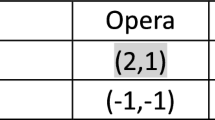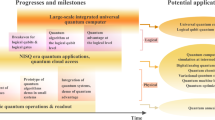Abstract
A probabilistic one-dimensional cellular automaton model by Domany and Kinzel is mapped into an inhomogeneous cellular automaton with the Boolean functions XOR and AND as transition rules. Wolfram's classification is recovered by varying the frequency of these two simple rules and by quenching or annealing the inhomogeneity. In particular, “class 4” is related to critical behavior in directed percolation. Also, the critical slowing down of second-order phase transitions is related to a stochastic version of the classical “halting problem” of computation theory.
Access this article
We’re sorry, something doesn't seem to be working properly.
Please try refreshing the page. If that doesn't work, please contact support so we can address the problem.
Similar content being viewed by others
References
C. H. Bennett and G. Grinstein,Phys. Rev. Lett. 55:657–660 (1985).
A. W. Burks,Essays on Cellular Automata (University of Illinois Press, 1970).
E. Domany and W. Kinzel,Phys. Rev. Lett 53 311–314 (1984).
D. Farmer, T. Toffoli, and S. Wolfram (eds.), Cellular automata,Physica D 10 (1–2) (1984);Cellular Automata (North-Holland, 1984).
P. Gacs and J. Reif, inProceedings of the Seventeenth ACM Symposium on the Theory of Computing, Providence, R.I., 1985 (ACM, 1985), pp. 388–395.
G. Grinstein, C. Jayaprakash, and Yu He,Phys. Rev. Lett. 55:2527–2530 (1985).
H. Hartman and G. Y. Vichniac, inDisordered Systems and Biological Organization, E. Bienenstock, F. Fogelman, and G. Weisbuch, eds. (Springer-Verlag, 1986).
B. Hayes,Sci. Am. 250(3):12–21 (1984).
S. A. Kauffman,Physica D 10:145–156 (1984).
W. Kinzel,Z. Phys. B 58:229–244 (1985).
W. Kinzel and J. M. Yeomans,J. Phys. A 14:L163-L168 (1981).
M. L. Minsky,Computation: Finite and Infinite Machines (Prentice-Hall, 1967).
A. L. Toom, inLocally Interacting Systems and Their Applications in Biology, R. L. Dobrushin, V. I. Kryukov, and A. L. Toom, eds., Lectures Notes in Mathematics, No. 653 (Springer-Verlag, 1978); inMulticomponent Random Systems, R. L. Dobrushin, ed.,Advances in Probabilities, Vol. 6 (Dekker, 1980), pp. 549–575.
J. von Neumann,Theory of Self-Reproducing Automata [ed. and completed by A. W. Burks], (University of Illinois Press, 1966).
S. Wolfram,Physica D 10:1–35 (1984).
Author information
Authors and Affiliations
Rights and permissions
About this article
Cite this article
Vichniac, G.Y., Tamayo, P. & Hartman, H. Annealed and quenched inhomogeneous cellular automata (INCA). J Stat Phys 45, 875–883 (1986). https://doi.org/10.1007/BF01020578
Received:
Revised:
Issue Date:
DOI: https://doi.org/10.1007/BF01020578




